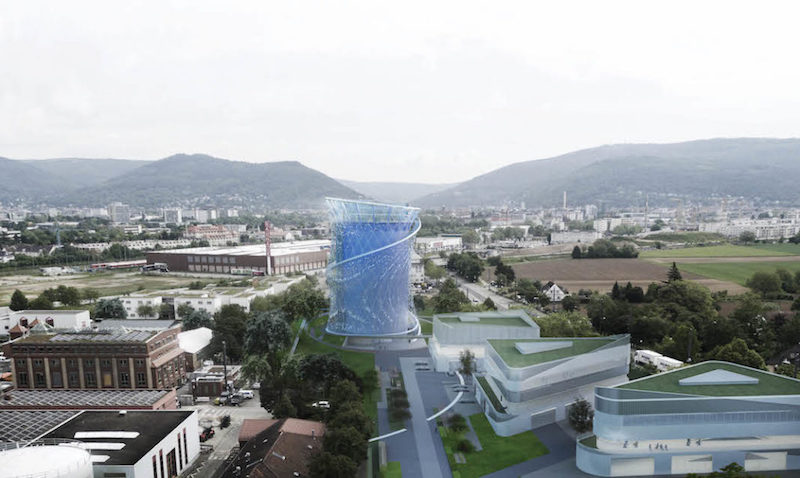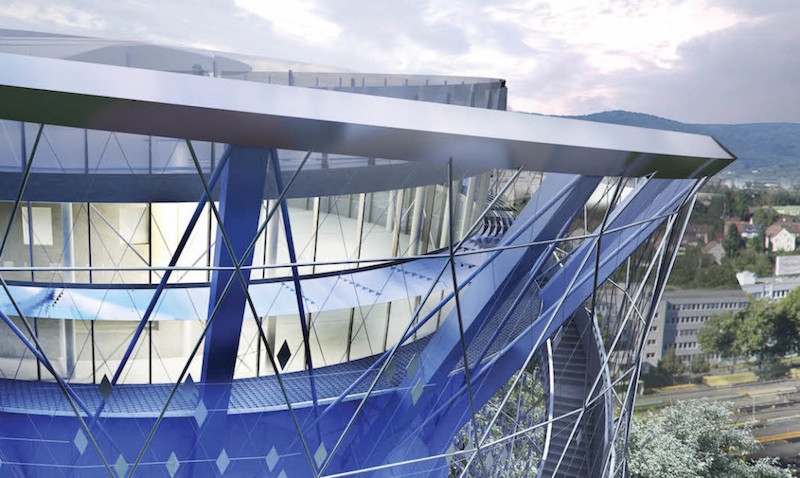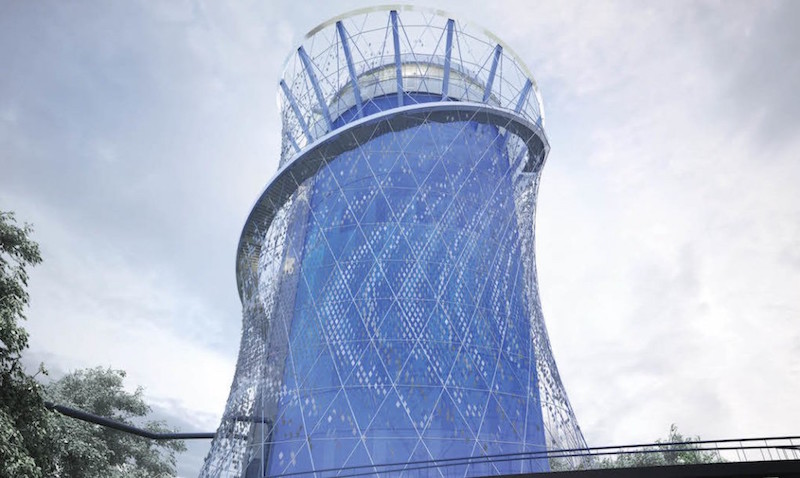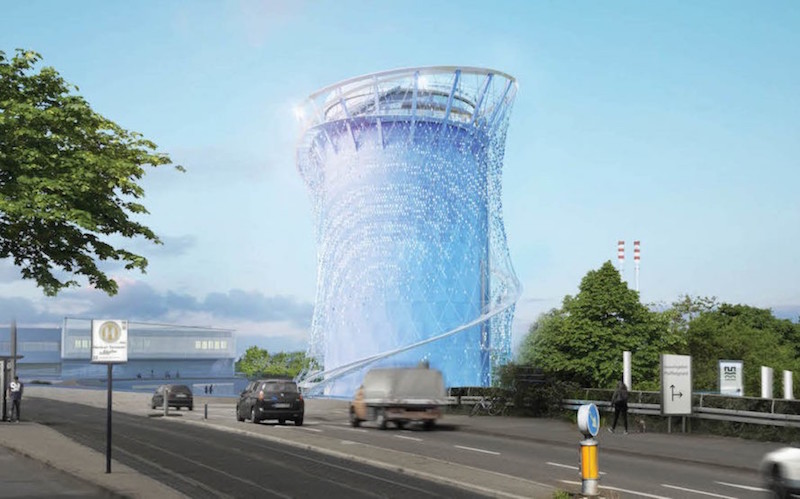The new design for an existing storage center in Heidelberg, Germany attempts to take an existing boring cylindrical tower and turn it into a knowledge center, tourist attraction, and symbol of the transition towards renewables.
The Laboratory for Visionary Architecture (LAVA) won a competition that sought a design for an energy park and accompanying energy storage tower. The tower will replace a gas storage tank with a water tank. Wind and solar energy harvested on site will heat the water, which will then be sold.
The new tower, which will be one of the tallest buildings in Heidelberg, is a multi-layered façade structure inspired by the geometries of nature. An inner shell colored in different shades of blue wraps around the building. Tilted elliptical rings are positioned around the cylinder and continue in the outer façade with “energy loops” that circle the structure all the way to the top. A cable network between the steel rings forms the outer façade layer.
 Rendering courtesy of LAVA.
Rendering courtesy of LAVA.
The building will receive its striking appearance courtesy of 11,000 diamond-shaped plates made of thin stainless steel. These plates are hooked with a connection system to a steel network that allows them to twist up to 45 degrees in the wind, which makes the building appear to move and fluctuate with the sun and wind.
Visitors to the new tower will enter through an elliptical entrance level where two elevators take them up to the roof, which comprises staggered terraces, event spaces, and a bistro. The roof can also be reached via a spiral staircase that travels around the outside of the tower.
 Rendering courtesy of LAVA.
Rendering courtesy of LAVA.
The building has recently broken ground and will rise 56 meters with a diameter of 26 meters. The accompanying energy park site will occupy 10,000 sm. Construction is scheduled for completion in 2019.
 Rendering courtesy of LAVA.
Rendering courtesy of LAVA.
Related Stories
| Nov 16, 2010
Green building market grows 50% in two years; Green Outlook 2011 report
The U.S. green building market is up 50% from 2008 to 2010—from $42 billion to $55 billion-$71 billion, according to McGraw-Hill Construction's Green Outlook 2011: Green Trends Driving Growth report. Today, a third of all new nonresidential construction is green; in five years, nonresidential green building activity is expected to triple, representing $120 billion to $145 billion in new construction.
| Nov 16, 2010
Calculating office building performance? Yep, there’s an app for that
123 Zero build is a free tool for calculating the performance of a market-ready carbon-neutral office building design. The app estimates the discounted payback for constructing a zero emissions office building in any U.S. location, including the investment needed for photovoltaics to offset annual carbon emissions, payback calculations, estimated first costs for a highly energy efficient building, photovoltaic costs, discount rates, and user-specified fuel escalation rates.
| Nov 11, 2010
USGBC certifies more than 1 billion square feet of commercial space
This month, the total footprint of commercial projects certified under the U.S. Green Building Council’s LEED Green Building Rating System surpassed one billion square feet. Another six billion square feet of projects are registered and currently working toward LEED certification around the world. Since 2000, more than 36,000 commercial projects and 38,000 single-family homes have participated in LEED.
| Nov 9, 2010
Just how green is that college campus?
The College Sustainability Report Card 2011 evaluated colleges and universities in the U.S. and Canada with the 300 largest endowments—plus 22 others that asked to be included in the GreenReportCard.org study—on nine categories, including climate change, energy use, green building, and investment priorities. More than half (56%) earned a B or better, but 6% got a D. Can you guess which is the greenest of these: UC San Diego, Dickinson College, University of Calgary, and Dartmouth? Hint: The Red Devil has turned green.
| Nov 9, 2010
U.S. Army steps up requirements for greening building
Cool roofs, solar water heating, and advanced metering are among energy-efficiency elements that will have to be used in new permanent Army buildings in the U.S. and abroad starting in FY 2013. Designs for new construction and major renovations will incorporate sustainable design and development principles contained in ASHRAE 189.1.
| Nov 3, 2010
First of three green labs opens at Iowa State University
Designed by ZGF Architects, in association with OPN Architects, the Biorenewable Research Laboratory on the Ames campus of Iowa State University is the first of three projects completed as part of the school’s Biorenewables Complex. The 71,800-sf LEED Gold project is one of three wings that will make up the 210,000-sf complex.
| Nov 3, 2010
Park’s green education center a lesson in sustainability
The new Cantigny Outdoor Education Center, located within the 500-acre Cantigny Park in Wheaton, Ill., earned LEED Silver. Designed by DLA Architects, the 3,100-sf multipurpose center will serve patrons of the park’s golf courses, museums, and display garden, one of the largest such gardens in the Midwest.
| Nov 3, 2010
Public works complex gets eco-friendly addition
The renovation and expansion of the public works operations facility in Wilmette, Ill., including a 5,000-sf addition that houses administrative and engineering offices, locker rooms, and a lunch room/meeting room, is seeking LEED Gold certification.
| Nov 3, 2010
Sailing center sets course for energy efficiency, sustainability
The Milwaukee (Wis.) Community Sailing Center’s new facility on Lake Michigan counts a geothermal heating and cooling system among its sustainable features. The facility was designed for the nonprofit instructional sailing organization with energy efficiency and low operating costs in mind.











